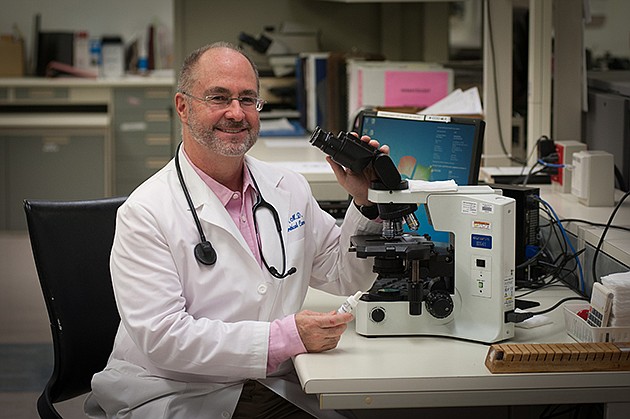- November 24, 2024
-
-
Loading

Loading

There's no doubt health care is a lot more high-tech today than it was 20 years ago. To start, both patients and doctors have a lot more information at their fingertips.
“You used to have to go to the medical library and pull articles,” says Dr. Kirk Voelker, medical director of Sarasota Memorial Health Care System's Clinical Research Center. “Now you have a whole medical library on your iPhone. That's a huge thing.”
Most patient records are now stored electronically rather than in file cabinets at a single doctor's office. This shift was intended to give any doctor easy access to a patient's records. It required providers to make some big changes in everything from workflow to staffing. And while it's led to some improvements, it's still not a perfect system due to a lack of uniformity among providers.
“There wasn't one or two mandated systems you could use, so hundreds of different software programs popped up for doing this,” says Dr. Kriston Kent, owner and medical director of the Kent Center for Life in Naples who was president of the Collier County Medical Society in 1997. “Some don't talk to each other and weren't required to do so.”
When it comes to the operating table, many surgeries that used to require major incisions are now done in a minimally invasive way outside of the hospital, at ambulatory care clinics or even doctors' offices.
“I'm a gynecologist and I have not opened up a belly in 10 to 15 years,” says Dr. Rafael Haciski, president of the Collier County Medical Society. “I do all of my major surgeries through laparoscopy, which was unthought of 20 years ago.”
All these technological advances have played a role in the rising cost of health care. Paying providers based on value and outcomes rather than volume has been talked about over the past several years, but it's easier said than done.
“Moving toward a value-based payment model has proved more complicated than people thought it would be,” says Dr. Larry Antonucci, chief operating officer for Lee Health. “It seems straightforward, but it's difficult to define value and quality.”
Haciski expects Medicare's Quality Payment Program, which begins taking effect in 2017, to make things even bleaker. “It's going to be a disaster when it really hits, and the public is completely unaware of it,” he says. “People already have a hard time when it comes to internal medicine, finding a doctor, and it's going to get worse.”
Preventive care — keeping patients out of the doctor's office in the first place — is another hot topic with its own set of challenges. “Our system still has a disease treatment and cure orientation rather than a prevention orientation,” says Dr. Jay Wolfson, associate vice president for health law, policy, and safety at USF Health. “Prevention isn't sexy. But we produce more diagnostic tests and prescribe more drugs than any other country on Earth, and we get the least bang for the buck for any of it.”
Local health care providers and the communities they serve will continue working on ways to incentivize patients to take more responsibility for their health. The data accumulated via the shift to electronic records will also help address individual and population health issues.
A lot of mergers and consolidation took place in the past 20 years. Instead of going it alone as they once did, many doctors have opted to be employed by hospitals or to band together with their peers, which offers everything from job security to negotiating power with insurers.
“Individual and small group practices have been declining very rapidly, as it's increasingly difficult for them to compete against medium- and larger-group practices,” says Wolfson.
There's also been a shift in who's providing patients with their health care. “There's been a large increase in what we call midlevel providers, like nurse practitioners and physicians assistants,” says Voelker. These providers take some of the patient load away from physicians, helping to triage patients and decrease wait times.
Patients are also staying healthy longer these days and expect to remain active well into their golden years. “Seventy years old is considered young now,” says Antonucci.
20 Years: By the numbers
Sarasota Memorial Hospital
Technology
1997: System was paper-driven. Had just begun upgrades to Windows 95. Imaging services were primarily film. SMH.com listed jobs and basic clinical services. Home page received about 400 hits a day and about 3,000 people checked out a job in 1997.
2017: System is now primarily paper-less. Medical records are electronic. Imaging services are digital with 3-D and other advanced capabilities. SMH.com includes patient portals and interactive tools for physicians and patients, in addition to job listings and blogs. Home page receives 3,060 hits a day and more than 186,000 people visited the hospital's careers website in 2016. SMH also has active social media sites, including Facebook, Twitter and YouTube
1997
Adult inpatient admissions: 24,269
Outpatient visit: 81,530
Emergency care visits: 55,985
Doctors on staff: About 550
2016/2017
Adult inpatient admissions: 28,042; small increase reflects a significant shift to outpatient care during past two decades.
Outpatient visits: More than 425,000
Emergency Care visits: 125,000; includes ERs in Sarasota and North Port.
Urgent Care visits: More than 100,000 patient visits a year.
Doctors on staff: More than 900
Source: Sarasota Memorial Hospital
20/20 vision
Fueled by massive population growth, key Florida industries have gone through massive transformations in the past two decades